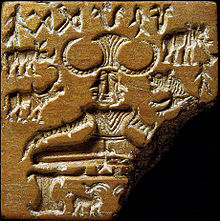Pashupati
| Pashupati | |
|---|---|
Lord of the Animals | |
 Lingam image of Pashupati in the Mandsaur temple, India | |
| Affiliation | Shaivism |
| Region | Indian subcontinent |
| Part of a series on |
| Shaivism |
|---|
 |
| Deities Parameshvara (Supreme being)
|
| Scriptures and texts
|
| Philosophy
|
| Practices |
| Schools
Saiddhantika Non - Saiddhantika
|
| Scholars |
| Related
|
 Hinduism portal Hinduism portal |
|
Pashupati (Sanskrit: पशुपति, IAST: Paśupati) is a Hindu deity and an incarnation of Shiva as the "Lord of the animals". Pashupati is mainly worshipped in Nepal and India. Pashupati is also the national deity of Nepal.
Etymology
Paśupati or Pashupatinatha, means "Lord of the animals". It was an epithet of Rudra in the Vedic period[1] and is one of the epithets of Shiva.[2]
History

The earliest claimed evidence of Pashupati comes from the Indus Valley civilization (3300 BCE to 1300 BCE), where the Pashupati seal has been said to represent a proto-Shiva figure.[3]
The Deity
Pashupatinath is an avatar of Shiva, one of the Hindu Trinity. He is the male counterpart of Shakti.
The five faces of Pashupatinath represent various incarnations of Shiva; Sadyojata (also known as Varuna), Vamdeva (also known as Uma Maheswara), Tatpurusha, Aghor and Ishana. They face West, North, East, South and Zenith respectively, representing Hinduism's five primary elements namely earth, water, air, light and ether.[4]
The Puranas describe these faces of Shiva as:
Sadyojata, Vamdeva, Tatpurusha & Aghora are the four faces, The fifth is Ishana, unknowable even to the seers.[4]
By country
Nepal

Although Nepal is a secular state, its population is predominantly Hindu. Pashupatinath is revered as a national deity.[5] The Pashupatinath Temple, located at the bank of the river Bagmati, is considered one of the most sacred places in Nepal. In mythology it is said that Pashupatinath started living in Nepal in the form of a deer because he was enchanted by the beauty of Kathmandu Valley.[citation needed]
India
A Pashupatinath temple is sited on the banks of the Shivana river in Mandsaur, Madhya Pradesh, India. It is one of the most important shrines of Mandsaur, and Shiva in the form of Pashupatinath is its primary deity. Its main attraction is a unique Shiva Linga displaying eight faces of Shiva. The shrine has four doors, representing the cardinal directions.[6][verify]
Pashupata Shaivism
Pashupata Shaivism is one of the oldest Shaivite sects that derives its name from Pashupati. The sect upholds Pashupati "as the supreme deity, the lord of all souls, and the cause of all existence".[7]
See also
References
- ^ Kramrisch 1981, p. 479.
- ^ Śarmā 1996, p. 291.
- ^ Marshall 1931, p. [page needed].
- ^ a b Parmeshwaranand 2004, [volume needed], p. 206
- ^ Feller & Mercel-Sanca, p. 148 [year missing].
- ^ "Pashupatinath Temple". shripashupatinath.nic.in. Archived from the original on 30 May 2013.
- ^ Dalal 2014, p. 923.
Sources
- Dalal, Roshen (2014). Hinduism: an Alphabetical Guide. London: Penguin Books. ISBN 978-81-8475-277-9. OCLC 1132344222.
- Feller, Tessa; Mercel-Sanca, Alan. Nepal: The Essential Guide to Customs & Culture. London: Kuperard.[year missing]
- Kramrisch, Stella (1981). The Presence of Śiva. Princeton, New Jersey: Princeton University Press. ISBN 0-691-01930-4.
- Marshall, John (1931). Mohenjo Daro and the Indus Civilization: being an official account of archæological excavations at Mohenjo-Daro carried out by the Government of India between the years 1922 ad 1927. Vol. 1. London: A. Probsthain. OCLC 903502370 – via Internet Archive.
- Parmeshwaranand, Swami (2004). Encyclopaedia of the Śaivism. New Delhi: Sarup & Sons. ISBN 978-81-7625-427-4. OCLC 54930404.
- Śarmā, Rāmakaraṇa (1996). Śivasahasranāmāṣṭakam : eight collections of hymns containing one thousand and eight names of Śiva. Delhi: Nag Publishers. ISBN 9788170813507. OCLC 36990863. Includes Śivasahasranāmakoṣa, a dictionary of names. This work compares eight versions of the Śivasahasranāmāstotra. The preface and introduction (in English) by Ram Karan Sharma provide an analysis of how the eight versions compare with one another. The text of the eight versions is given in Sanskrit.
Further reading
- Flood, Gavin D. (1996). An Introduction to Hinduism. New York, NY: Cambridge University Press. ISBN 978-0-521-43304-4. OCLC 1150048129 – via Internet Archive.
- Flood, Gavin D. (2003). The Blackwell Companion to Hinduism. Oxford: Blackwell Pub. ISBN 978-1-4051-2306-8. OCLC 53366821.
- Michaels, Axel; Harshav, Barbara (2004). Hinduism: Past and Present. Princeton, N.J.: Princeton University Press. ISBN 978-0-691-23401-4. OCLC 1264088953.
- Possehl, Gregory (2002). The Indus Civilization: A Contemporary Perspective. Lanham: AltaMira Press. ISBN 978-0-7591-1642-9. OCLC 854521113.
- Zimmer, Heinrich (1972). Campbell, Joseph (ed.). Myths and Symbols in Indian Art and Civilization. Princeton, New Jersey: Princeton University Press. ISBN 978-0-691-01778-5. OCLC 899987831.












